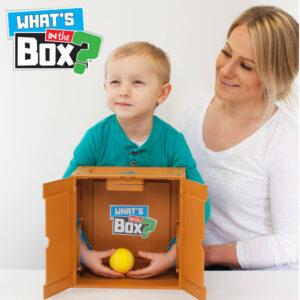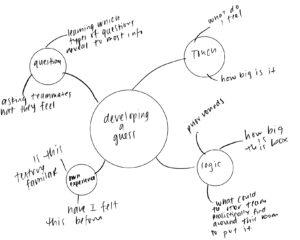
Game/Theme: For this assignment, I played a slightly moded version of “What’s in the Box,” a children’s game where one team/player places an item in a box and another player must guess the object by only touching it. The box opens on one side to allow other players/onlookers to see the item and participate as well. The other team must guess only by asking yes or no questions. In Bottoms Up, one team creates a mystery cocktail and the other team has to guess the ingredients. Instead of using touch, are game uses taste to make guesses.
Since I did not have direct access to this game, I made a variation of it involving a box that a player had to reach into and feel with blindfolds on. However, after one round, I realized the part of the communal fun of the game is the ability for players to watch the game as it unfolds. Therefore, I played a round where we tore a hole in the box, then a round where a player simply held the item, but as blindfolded and everyone could watch.
Mechanics:
The mechanics of this game are:
- One team attempts to pick the most difficult item possible (either an unexpected texture, or unexpected object) that will stump the other team
- For the second round, my friend used a bunch of crushed leaves that was incredibly difficult to figure out what they were!
- The other team uses tactical clues and guesses to narrow down what the object is.
- A time element: when we played, we reduced the rounds to 5 minutes to keep the urgency and prevent a round from going too long.
- We also implemented a rule where the whole team could be blindfolded and all participate in guessing the object to keep everyone involved.
From these mechanics, dynamics emerge:
- Bluffing, the other team must stay calm and composed regardless of what the player is guessing. For example, any clue that the player is getting closer to the answer or further away will hurt the team.
- Given the asymmetry of information, one team knows the object, the other team does not, there is a lot of communication. In the version where we had two teams, and everyone on the guessing team wore blindfolds and guessed, I found that there was a lot of communication emerging within the team.
- Pigenholing. As you move further into feeling an object, you become increasingly convinced of what you think it is and develop questions around it; however, sometimes this is completely off-base. This creates a dynamic where it is really easy to waste time being completely off base.
From these dynamics, fun emerges:
- Fellowship: the guessing team must work together and take turns touching the object and asking questions to narrow down what the object may be
- Challenge: both teams are working against the timer to try and guess/keep the answer hidden as long as they can
- Discovery: within a round, it is a single process of trying to discover what this object it!
These types of fun emerge from the process of collectively trying to guess what the object is and using tactical evidence, communication among the team as everyone feels the object, and the process of discovery (not knowing and progressively getting closer) to create a fun sense of discovery and panic as time runs out.
This fun is reinforced by the ability for viewers on the other team/onlookers to watch the other team touch the object. In the formal game design of What’s in the Box, the box has an opening that allows everyone to watch where/how the guesser is touching the object and therefore follow along with their train of thought. Watching as the guesser correctly associates tactual clues with the object or incorrectly assumes a series of string lights are beads, for example, is extremely amusing.
This game differentiates itself from other team-guessing party games (Charades for example) by being incredibly fluid in its dynamic. This game can be played 1v.1 or team v. team, it is amusing to watch even if you are not involved. There does not appear to be any explicit abuse risks, except if a team decides to make the mystery object an inappropriate or offensive object.
How would I improve the game?
As I played it, I quickly began diagraming where/how decisions are made:
When thinking about why this game works and what makes it fun, I realize it comes entirely through how the guesser makes a guess.
- As they touch the object, they are using tactile clues. What do I fell, how big is it?
- At the same time, they use logic: how big is this box, what could the other team realistically find around this dorm room to put in here, prior rounds.
- Further, they use their own experience: is this texture familiar? Have I felt this before?
- Last, they use questions. Progressively learning what types of questions reveal the most information, which questions to ask first to narrow the scope, asking questions to their teammates that are also feeling the object.
A way to expand the fun of this game is to see if there could be a way expand the guessing mechanic and further indulge the team vs. team element. For example, this could be implemented through a specific number of questions allowed, playing around with time limit. Alternatively, perhaps a team can be given 2 objects and must divide themselves into 2 subgroups and must work together to not only identify their object through asking questions to the other team, but then also ask questions to their teammates and identify what unifies the two different objects. For example, one half of the team feels a football, the other half feels a baseball. Perhaps they have to work together to identify that their unifying theme is sports!



